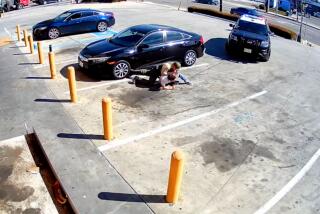Officer in King Beating Released to Halfway House : Police: Laurence M. Powell goes to a facility in Garden Grove after serving 24 months of his term in federal prison.
- Share via
Laurence M. Powell, one of two Los Angeles police officers convicted in the 1991 videotaped beating of motorist Rodney G. King, has been released to an Orange County halfway house after serving 24 months in federal prison, authorities said Monday.
Powell left the federal prison camp in the Mojave Desert town of Boron last Tuesday for the My Break Transitional Center in Garden Grove, a two-story apartment building complete with amenities such as a shaded picnic table, a swimming pool and an outdoor deck sporting weight-training equipment.
He has 15 days to find a job, said U.S. Bureau of Prisons spokeswoman Pat Ellington, who oversees halfway houses in Southern California. Ellington said she did not know what sort of work Powell--who was a Municipal Court clerk before joining the Los Angeles Police Department in 1987--is seeking. He was not available Monday for interviews.
“The whole purpose [of the halfway house] is to acquire employment and residence prior to release,” Ellington said. Powell is scheduled to be released Dec. 13, she said.
That release date remains uncertain, however, because the U.S. Supreme Court last Wednesday announced it will consider arguments over the length of the prison terms handed down to Powell and former Sgt. Stacey C. Koon, the other officer convicted in federal court in 1993 of violating King’s constitutional rights.
The federal convictions followed not-guilty verdicts in state court for Powell, Koon and two other white officers on charges of assault and excessive use of force in the March, 1991, beating of King, a black motorist. The state court verdicts touched off deadly riots in Los Angeles and prompted the federal court prosecutions that led to convictions for Powell and Koon. Powell was convicted of beating King, Koon of allowing the beating to occur.
In August, 1993, U.S. District Judge John G. Davies sentenced both Powell and King to 30-month terms. Those terms are far less than the sentence called for by U.S. sentencing guidelines, which took effect in 1988 and eliminate, to a large degree, the discretion of trial judges in imposing sentences.
In the case of Powell and Koon, Davies said the guidelines called for a term between 70 and 82 months. However, Davies cited several reasons for leniency and also volunteered that a “specter of unfairness” hangs over their convictions because the federal trial came after the state court acquittals.
Both men went to prison in October, 1993. Koon, being held at a federal prison in Oregon, is scheduled to be released Dec. 14, according to authorities.
Prosecutors contested the 30-month sentences, saying they were too short. The U.S. 9th Circuit Court of Appeals ruled that Davies had erred in showing leniency.
The U.S. Supreme Court argument is set for January, Powell’s Santa Ana attorney, William J. Kopeny said Monday. If the high court rules for the former officers, it will not change their situation because their sentence will be complete. If the court rules for the government, however, Davies will be obliged to sentence them to a longer term--meaning Powell and Koon would go back to prison.
But for the next couple of months, Powell will be among those living at My Break, a 49-bed facility in a middle-class neighborhood off Katella Avenue.
Executive Director Harvey De Meneces declined Monday to comment on Powell but said: “People in this program are really trying to make it, and everyone really does deserve an opportunity.” The typical inmate at the 49-bed facility, De Meneces said, shares a six-bed unit with other recently released inmates, all minimum security risks. Room and board--breakfast, a sack lunch and dinner--costs $48.70 daily, and each inmate is required to set aside 25% of his wages toward that fee.
The inmates, he said, are “really very accountable, as accountable as they can be in a community center.”
More to Read
Sign up for Essential California
The most important California stories and recommendations in your inbox every morning.
You may occasionally receive promotional content from the Los Angeles Times.













